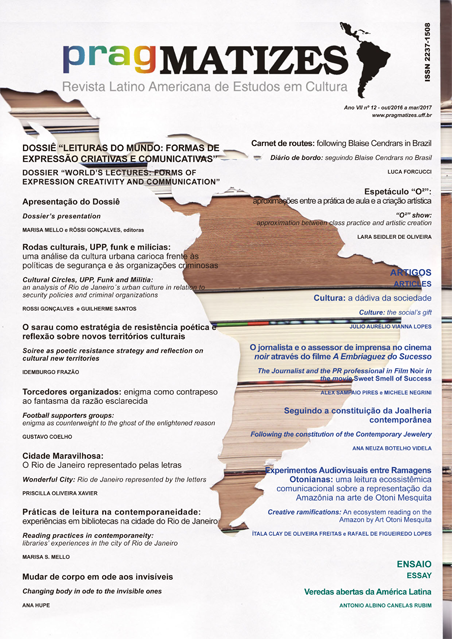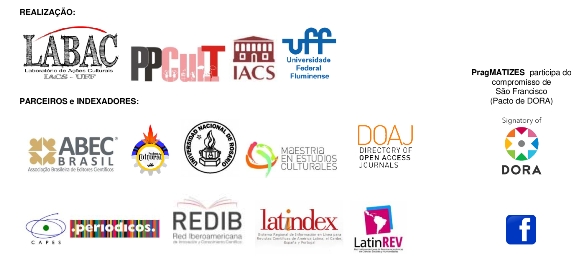”O²” Show: approximation between class practice and artistic creation
DOI:
https://doi.org/10.22409/pragmatizes.v0i12.10450Abstract
This article presents the dynamics of artistic and academic production developed in the Research Project D.O.A. (Dance and other art) of the Department of Body Art at Federal University of Rio de Janeiro (UFRJ) and the peculiar aspects present in the dance research process, regarding body preparation and choreographic composition, based on a theoretical-practical methodology. This research project began in 2012, and focuses on the current research on the construction of different gestural qualities that triggered the contemporary dance show entitled “O²” from the analysis, experience and recreation of some practices, approaches and body techniques already established, such as: Pilates, techniques of meditation and contemporary dance, under a somatic-creative look. From the description of the show, it is intended to discuss the methodology used that was based first, the identification of some principles that govern these techniques, then in the recreation and diversification of these principles in different gestural situations in classes and third in the creation of scripts and scenes. All bodily experiences in the classes were driven by strategies based on somatic thinking (body-soma) introduced by the American philosopher Thomas Hanna in the 1970s and widely used today by teachers and dance artists who understand and work on the subjectivity of Bodily experience, about the particular aspects of individual way of feeling, perceiving and moving, and that access questions that arise only in and during the experience of the body. The body, not understood as dead flesh, but as a living body, where one sees the “I, the corporeal being” or in the practice where the subject sees himself as subject and object of experience. In addition, the work intends to present the creative methodology that permeated all classroom practice and scenic composition, based on the studies developed by Professor Emérita Helenita Sá Earp, which emphasizes the importance of the development of creativity as the main attribute of a teacher or a dancer, who bases all knowledge about the body in dance on fundamental principles of human action governed by the notion of Movement, Space-Shape, Dynamics and Time. The choice of such bodily approaches and practices was not only limited to the body preparation of the performer but provided the thematic element in the artistic composition: breathing. In this sense, the creation process was intended to approximate the practice of class and the scenic practice from the first idea that the act of dancing does not separate the creative act from the technical act, especially when governed by the thought that doing in dance is imbued with a sensible, physical and creative engagement. In addition, the study proposed a specific research in the sense of rethinking, recreating somebody approaches from their fundamental bases for the creation of new stimulus / exercises and corporal experiences in classes and, together, for the elaboration of an artistic product from a Somatic and creative practice.Downloads
References
BOTTIGLIERI, Carla. D'un sujet qui "prend corps": L'espérience somatique entre modes de subjetivation et processus d'individuation In De l'une à l'outre.: composer, aprprendre er partager en mouvements. Ouvrage Coletif, Contredanse, Bruxelles, 2010.
BRENNAN, Barbara Ann. Mãos de Luz. São Paulo: Pensamento, 2006.
CAPRA, Fritjof. O Ponto de Mutação. Editora Cultrix, São Paulo, 1980
CONHEN, Bonie Bainbridge. Embodiment In De l'une à l'outre.: composer, aprprendre er partager en mouvements. Ouvrage Coletif, Contredanse, Bruxelles, 2010.
EARP, Ana Célia. S. Aulas práticas e teóricas da disciplina “Fundamentos Gerais da Dança” e “Fundamentos da Dança A” do Curso de Bacharelado em Dança da UFRJ. Segundo semestre, 1995.
________________. Princípios de conexões dos movimentos básicos em suas relações anátomo-cinesiológicas na dança segundo Helenita Sá Earp. In VI Congresso de pesquisa e pós-graduação em artes cênicas, 2010.
EARP, Helenita de Sá Earp. Atividades rítmicas educacionais. Exposição feita na Escola Nacional de Educação Física da Universidade do Brasil, quando da segunda reunião de professores de educação física, realizada em abril de 1947.
________________________. Síntese pedagógica das atividades rítmicas educacionais. Conferência realizada no curso aberto pela Associação de Professores de Educação Física do Distrito Federal, em 3 de novembro de 1948.
________________________. Ginásio de ginástica rítmica da escola nacional de educação física e desportos. Noticiário realizado na festa de encerramento das atividades do ano letivo e inauguração das novas instalações do Ginásio de Ginástica Rítmica da Escola nacional de Educação Física e Desportos, em 4 de dezembro de 1954.
LIMA, André Meyer Alves de. DANÇA E CIÊNCIA: estudo acerca de processos de roteirização e montagem coreográfica baseados em formas e padrões de organização biológicos a partir dos Fundamentos da Dança de Helenita Sá Earp. Tese de Doutorado submetida ao Programa de Pós-Graduação em Química Biológica na Área de Concentração em Educação, Difusão e Gestão em Biociências do Instituto de Bioquímica Médica da Universidade Federal do Rio de Janeiro. Rio de janeiro, 2012.
FILHO, Arílio de Cerqueira Filho. Energia dos Cakras: saúde e autotransformação. Cuiabá: Pleinitude Humana, 2013.
FORTIN, Sylvie. Educação Somática: novo ingrediente na formação prática em dança. In: Cadernos do GIPE-CIT, Salvador, Universidade Federal da Bahia, n. 2, p. 40-55, 1999.
FORTIN, Sylvie; Vieira, Adriane; Tremblay, Martyne A experiência de discursos na dança e na educação somática. Movimento, vol. 16, núm. 2, abril-junio, 2010.
GUIMOND, O. L’éducation somatique: un changement de paradigme. Sans préjudice... pour la santé des femmes, Réseau québécois d’action pour la santé des femmes, v. 18, p. 5-6, 1999.
PEREIRA,Carlos Augusto Santana. A dança na universidade moderna: apontamentos a partir de um estudo do currículo do curso de bacharelado em dança da Universidade Federal do Rio de Janeiro. In Arquivos em Movimento. Revista eletrônica da Escola de Educação Física e Desportos- UFRJ. V.4, n.1, janeiro/junho, 2008.
SILER Brooke. O Corpo Pilates : um guia para o fortalecimento, alongamento e tonificação sem o uso de máquinas. São Paulo: Summus, 2008.
Downloads
Published
How to Cite
Issue
Section
License
By forwarding an original to PragMATIZES, the authors agree that the copyright related to it is transferred to the Publishing. Articles and other writings are made available in PDF format from their publication, and they can be downloaded to institutional repositories and personal pages, provided that with their proper bibliographic indication.



